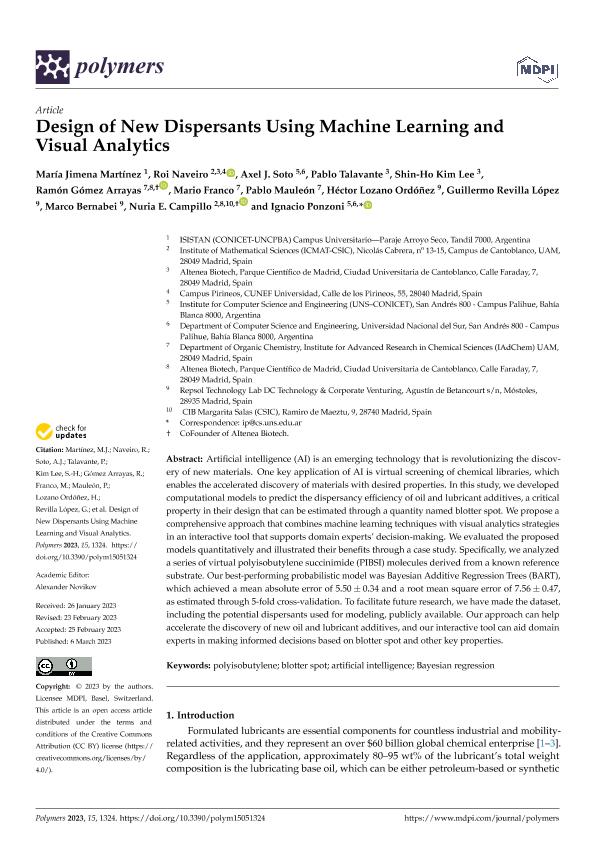Artículo
Design of New Dispersants Using Machine Learning and Visual Analytics
Martínez, María Jimena ; Naveiro, Roi; Soto, Axel Juan
; Naveiro, Roi; Soto, Axel Juan ; Talavante, Pablo; Kim Lee, Shin Ho; Gómez Arrayas, Ramón; Franco, Mario; Mauleón, Pablo; Lozano Ordóñez, Héctor; Revilla López, Guillermo; Bernabei, Marco; Campillo, Nuria E.; Ponzoni, Ignacio
; Talavante, Pablo; Kim Lee, Shin Ho; Gómez Arrayas, Ramón; Franco, Mario; Mauleón, Pablo; Lozano Ordóñez, Héctor; Revilla López, Guillermo; Bernabei, Marco; Campillo, Nuria E.; Ponzoni, Ignacio
 ; Naveiro, Roi; Soto, Axel Juan
; Naveiro, Roi; Soto, Axel Juan ; Talavante, Pablo; Kim Lee, Shin Ho; Gómez Arrayas, Ramón; Franco, Mario; Mauleón, Pablo; Lozano Ordóñez, Héctor; Revilla López, Guillermo; Bernabei, Marco; Campillo, Nuria E.; Ponzoni, Ignacio
; Talavante, Pablo; Kim Lee, Shin Ho; Gómez Arrayas, Ramón; Franco, Mario; Mauleón, Pablo; Lozano Ordóñez, Héctor; Revilla López, Guillermo; Bernabei, Marco; Campillo, Nuria E.; Ponzoni, Ignacio
Fecha de publicación:
03/2023
Editorial:
MDPI
Revista:
Polymers
ISSN:
2073-4360
Idioma:
Inglés
Tipo de recurso:
Artículo publicado
Clasificación temática:
Resumen
Artificial intelligence (AI) is an emerging technology that is revolutionizing the discovery of new materials. One key application of AI is virtual screening of chemical libraries, which enables the accelerated discovery of materials with desired properties. In this study, we developed computational models to predict the dispersancy efficiency of oil and lubricant additives, a critical property in their design that can be estimated through a quantity named blotter spot. We propose a comprehensive approach that combines machine learning techniques with visual analytics strategies in an interactive tool that supports domain experts’ decision-making. We evaluated the proposed models quantitatively and illustrated their benefits through a case study. Specifically, we analyzed a series of virtual polyisobutylene succinimide (PIBSI) molecules derived from a known reference substrate. Our best-performing probabilistic model was Bayesian Additive Regression Trees (BART), which achieved a mean absolute error of (Formula presented.) and a root mean square error of (Formula presented.), as estimated through 5-fold cross-validation. To facilitate future research, we have made the dataset, including the potential dispersants used for modeling, publicly available. Our approach can help accelerate the discovery of new oil and lubricant additives, and our interactive tool can aid domain experts in making informed decisions based on blotter spot and other key properties.
Palabras clave:
ARTIFICIAL INTELLIGENCE
,
BAYESIAN REGRESSION
,
BLOTTER SPOT
,
POLYISOBUTYLENE
Archivos asociados
Licencia
Identificadores
Colecciones
Articulos (ICIC)
Articulos de INSTITUTO DE CS. E INGENIERIA DE LA COMPUTACION
Articulos de INSTITUTO DE CS. E INGENIERIA DE LA COMPUTACION
Articulos(ISISTAN)
Articulos de INSTITUTO SUPERIOR DE INGENIERIA DEL SOFTWARE
Articulos de INSTITUTO SUPERIOR DE INGENIERIA DEL SOFTWARE
Citación
Martínez, María Jimena; Naveiro, Roi; Soto, Axel Juan; Talavante, Pablo; Kim Lee, Shin Ho; et al.; Design of New Dispersants Using Machine Learning and Visual Analytics; MDPI; Polymers; 15; 5; 3-2023; 1-18
Compartir
Altmétricas



